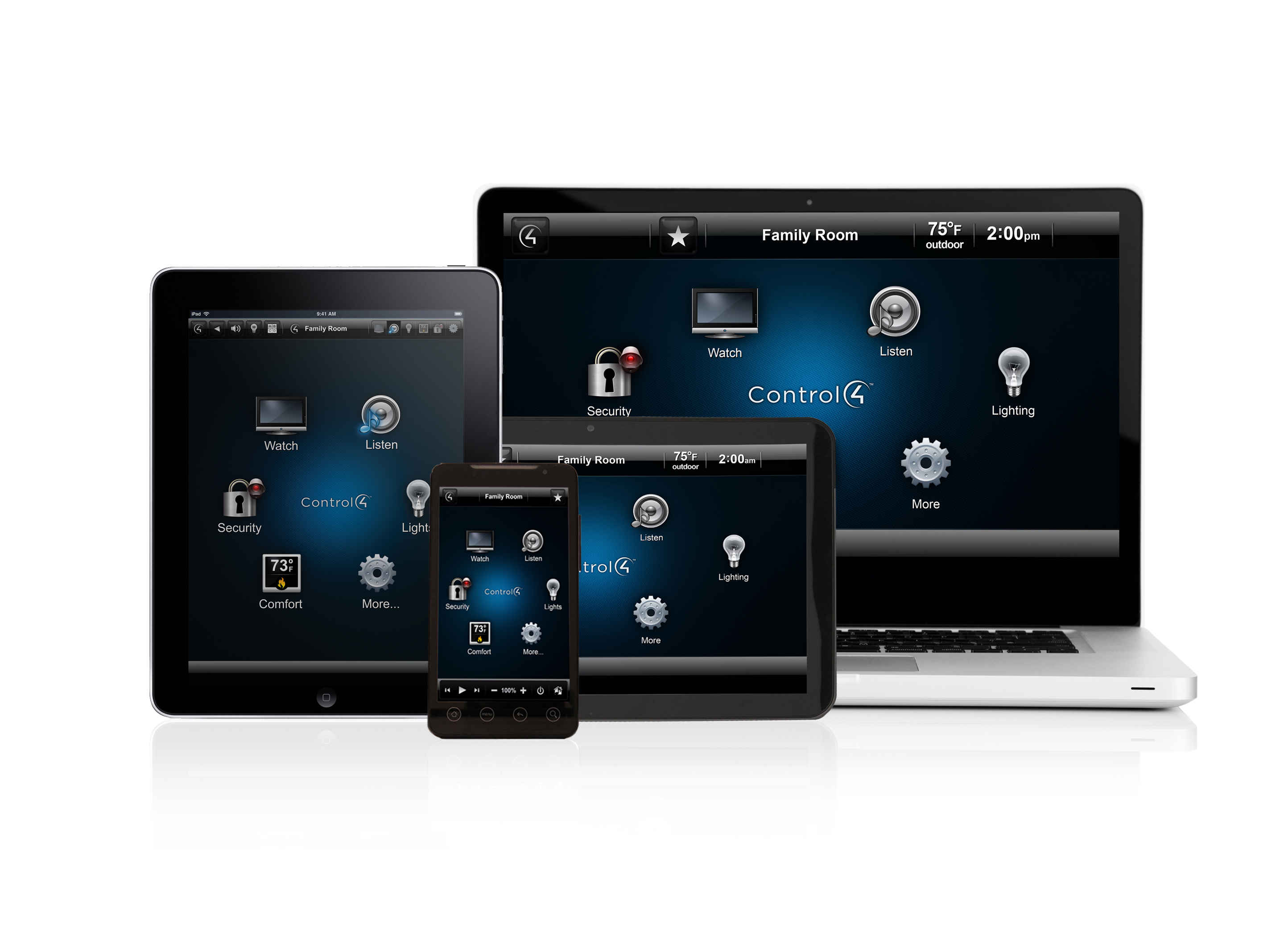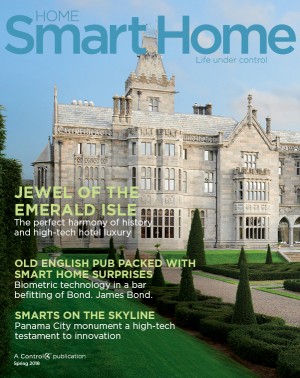User Interfaces—The Human Link to a Home Automation System
By Guest | Posted November 18, 2014Automation occurs when the state of a device, product or system changes without any human interaction. It happens when your home environment is able to adapt to your needs all by itself—no tap of a button or a flip of a switch is required. While home automation systems are perfectly capable of running a household in this hands-off fashion, many homeowners feel more comfortable being able to actively operate the various products and systems under the backing of an automation system. Rather than relying completely on a system to tell the lights, thermostats, A/V equipment and other devices how and when to adjust, they like having the power to make these changes, too, and the tool they use to do so is what the industry refers to as a “user interface.” A user interface is basically a device that enables a person to easily monitor the status of the every product that has been tied to a home automation system and to control these products on the fly. So even though an automation system may have been programmed to adjust the settings of the lights, thermostats, motorized shades and A/V equipment at a certain time of day, thanks to a user interface, homeowners are free to bend the rules and make changes however and whenever they want. For this reason, a user interface is one of the most important parts of an automation system. It’s the one piece of technology that you’ll see and touch multiple times every single day. You’ll rely on it to dispense useful real-time information about your system and to provide a quick and easy way to control multiple devices from one main point of contact.
This point of contact can come in many different forms, and while no one type of user interface is better than the other, it helps to understand the key benefits and applications of each. In most cases, home automation integrators will specify a combination of user interfaces so that homeowners can benefit from each device’s unique capabilities and features. Here’s a rundown of the various user interfaces available today, along with advice on the types of tasks for which each is best suited.
Tablets and Smartphones
The trendiest types of user interfaces are control apps that manufacturers offer (usually free) to download onto your iOS and/or Android smartphone or tablet. You might already be familiar with the type of app that can control a specific individual device, and while this is a handy way to operate an electronic door lock, for example, the apps offered by home automation manufacturers are designed to facilitate the control of multiple devices—door locks, thermostats, lights, A/V equipment and more. From a single app on a smartphone or tablet, you can command every electronic device in your home. It’s a highly convenient mode of control for people who carry a mobile device with them at all times. It’s also an ideal type of interface for monitoring and managing a home automation system remotely while you’re at work or traveling. You can activate the app from anywhere in the world to manage your home’s environment as easily as if you were seated on the sofa in your living room.
Dedicated Touch Screens
In addition to downloadable apps, most manufacturers of home automation systems offer user interfaces in the form of dedicated touch screens. Available in a variety of sizes and price ranges, from small, wireless, portable units that can rest on a coffee table or nightstand to super-size models meant to be mounted permanently to the wall, touch screens are highly customizable and can suit a variety of control applications.
Because the screen is usually larger than that of a tablet or smartphone, a touch screen is able to present information in a way that many people find easier to read and navigate. Moreover, while the design of a control app is fairly static, the control menus and icons displayed on the screen of a dedicated home automation touch screen are flexible, meaning a home automation professional can customize the layout, color scheme and other features to suit your preferences.
Due to its ability to be customized and its comfortable screen size, a touch screen is an ideal user interface for automation systems that are large in scope. By scrolling through “pages” on the panel, a user can view the status of and command buttons for lighting, move on to the heating and cooling page, the audio/video page, and so on. When designed appropriately, touch screens are able to dramatically simplify the control of very complex automation systems; therefore, they are often assigned the role of “command central” in a home, and are located in an area, such as a kitchen, where a family might spend most of their time. As a bonus, some touch screens are able to display video from surveillance cameras, pull entertainment content (music and video) from a whole-house A/V system and function as an intercom station.
Keypads and Handheld Remotes
Employing hard buttons instead of screen-based graphics to zip commands to electronic systems and products, wall-mounted keypads and handheld remotes may not have the sizzle of mobile apps and touch screens, yet they are still widely used in automated homes. For starters, they’re simple and straightforward—a good type of interface to use when you just want to quickly turn on a group of lights, open wall of drapes or activate the A/V gear in a home theater, for example.
Like other types of interfaces, keypads and automation-friendly remotes can be customized to look and perform to your specifications. Buttons can be labeled to say what you want and to do what you want. For example, when pressed, a button labeled “Snack” on a keypad by the bed could illuminate a pathway from the bedroom to the kitchen. A “Showtime” command issued from a remote, meanwhile, could prepare the lights, shades and A/V equipment in the living room for family movie night. Because they’re the type of interface that stays in one spot, they are ideal for controlling the environment within a particular room.
This point of contact can come in many different forms, and while no one type of user interface is better than the other, it helps to understand the key benefits and applications of each. In most cases, home automation integrators will specify a combination of user interfaces so that homeowners can benefit from each device’s unique capabilities and features. Here’s a rundown of the various user interfaces available today, along with advice on the types of tasks for which each is best suited.
Tablets and Smartphones
The trendiest types of user interfaces are control apps that manufacturers offer (usually free) to download onto your iOS and/or Android smartphone or tablet. You might already be familiar with the type of app that can control a specific individual device, and while this is a handy way to operate an electronic door lock, for example, the apps offered by home automation manufacturers are designed to facilitate the control of multiple devices—door locks, thermostats, lights, A/V equipment and more. From a single app on a smartphone or tablet, you can command every electronic device in your home. It’s a highly convenient mode of control for people who carry a mobile device with them at all times. It’s also an ideal type of interface for monitoring and managing a home automation system remotely while you’re at work or traveling. You can activate the app from anywhere in the world to manage your home’s environment as easily as if you were seated on the sofa in your living room.
Dedicated Touch Screens
In addition to downloadable apps, most manufacturers of home automation systems offer user interfaces in the form of dedicated touch screens. Available in a variety of sizes and price ranges, from small, wireless, portable units that can rest on a coffee table or nightstand to super-size models meant to be mounted permanently to the wall, touch screens are highly customizable and can suit a variety of control applications.
Because the screen is usually larger than that of a tablet or smartphone, a touch screen is able to present information in a way that many people find easier to read and navigate. Moreover, while the design of a control app is fairly static, the control menus and icons displayed on the screen of a dedicated home automation touch screen are flexible, meaning a home automation professional can customize the layout, color scheme and other features to suit your preferences.
Due to its ability to be customized and its comfortable screen size, a touch screen is an ideal user interface for automation systems that are large in scope. By scrolling through “pages” on the panel, a user can view the status of and command buttons for lighting, move on to the heating and cooling page, the audio/video page, and so on. When designed appropriately, touch screens are able to dramatically simplify the control of very complex automation systems; therefore, they are often assigned the role of “command central” in a home, and are located in an area, such as a kitchen, where a family might spend most of their time. As a bonus, some touch screens are able to display video from surveillance cameras, pull entertainment content (music and video) from a whole-house A/V system and function as an intercom station.
Keypads and Handheld Remotes
Employing hard buttons instead of screen-based graphics to zip commands to electronic systems and products, wall-mounted keypads and handheld remotes may not have the sizzle of mobile apps and touch screens, yet they are still widely used in automated homes. For starters, they’re simple and straightforward—a good type of interface to use when you just want to quickly turn on a group of lights, open wall of drapes or activate the A/V gear in a home theater, for example.
Like other types of interfaces, keypads and automation-friendly remotes can be customized to look and perform to your specifications. Buttons can be labeled to say what you want and to do what you want. For example, when pressed, a button labeled “Snack” on a keypad by the bed could illuminate a pathway from the bedroom to the kitchen. A “Showtime” command issued from a remote, meanwhile, could prepare the lights, shades and A/V equipment in the living room for family movie night. Because they’re the type of interface that stays in one spot, they are ideal for controlling the environment within a particular room.

